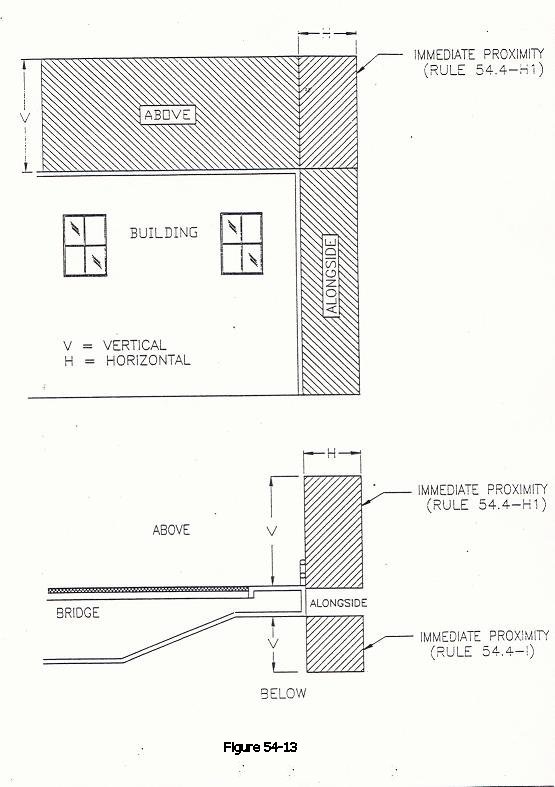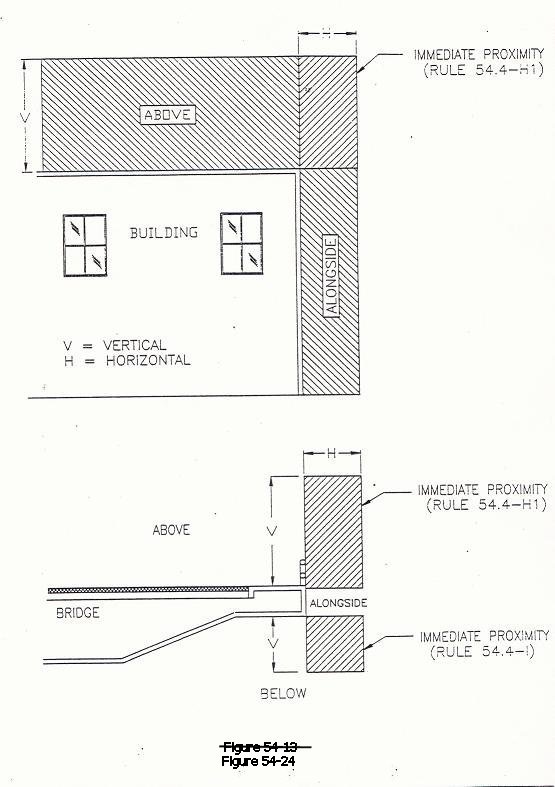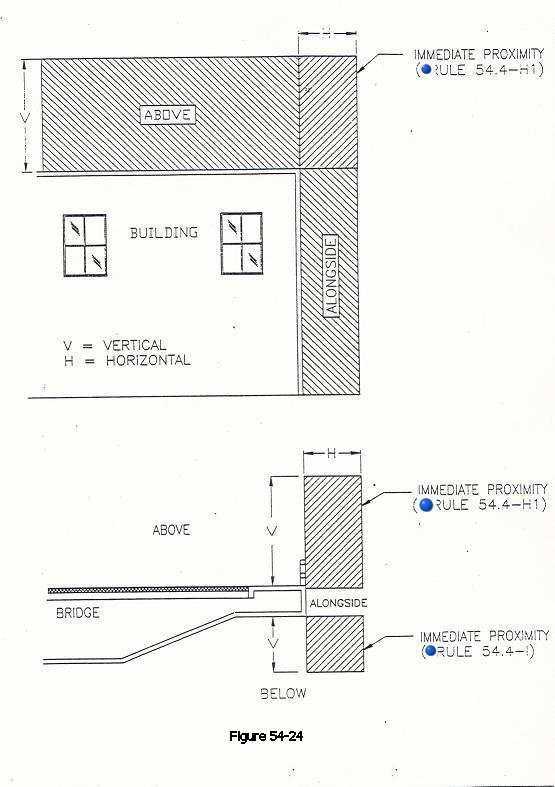
Original Version
Rule 54.4-H1
54.4-H1) Unattached Conductors: Conductors should be arranged so as not to hamperor endanger workers and firefighters while performing their duties. The basic clearances of conductors from buildings are specified in Table 1, Cases 6 and 7. The horizontal clearance (Table 1, Case 7) shall be maintained until the vertical clearance (Table 1, Case 6) is attained (see Fig. 54-13). The horizontal clearance The requirements of Table 1, Cases 7 also apply at fire escapes, exits, windows, etc., at which human contact may be reasonably expected.
EXCEPTION: The horizontal conductor clearance from buildings may be reduced from 6 feet to 4 feet ( Table 1, Case 7, Column E ) if all of the following criteria are met:
a) The conductor voltage is 7,500 volts or less; and
b) The conductor vertical clearance above ground is more than 35 feet; and
c) The building height next to the conductors exceeds the conductor height by 6 feet or more; and
d) There are no fire escapes, exits, or windows at which human contact may be reasonably expected.
Note: See Rule 54.8–B4 for service drop clearance requirements and Table 58–1 for special treatment of bus and lead wires of transformer installations in alleys.

Strikeout and Underline Version
Rule 54.4-H1
54.4-H1)
Unattached Conductors: Conductors should
be arranged so as not to hamperor endanger workers and firefighters while
performing their duties. The basic
clearances of conductors from buildings are specified in Table 1, Cases 6 and
7. The horizontal clearance (Table 1,
Case 7) shall be maintained until the vertical clearance (Table 1, Case 6) is
attained (see Fig. 54-13 24). The
horizontal clearance The requirements
of Table 1, Cases 7 also apply at fire escapes, exits, windows, etc., at which
human contact may be reasonably expected.
EXCEPTION: The horizontal conductor clearance from buildings may be reduced from 6 feet to 4 feet ( Table 1, Case 7, Column E ) if all of the following criteria are met:
a) The conductor voltage is 7,500 volts or less; and
b) The conductor vertical clearance above ground is more than 35 feet; and
c) The building height next to the conductors exceeds the conductor height by 6 feet or more; and
d) There are no fire escapes, exits, or windows at which human contact may be reasonably expected.
Note: See Rule 54.8–B4 for service drop clearance requirements and Table 58–1 for special treatment of bus and lead wires of transformer installations in alleys.

Final Version
Rule 54.4-H1
54.4-H1) Unattached Conductors: Conductors should be arranged so as not to hamperor endanger workers and firefighters while performing their duties. The basic clearances of conductors from buildings are specified in Table 1, Cases 6 and 7. The horizontal clearance (Table 1, Case 7) shall be maintained until the vertical clearance (Table 1, Case 6) is attained (see Fig. 54-24). The horizontal clearance The requirements of Table 1, Cases 7 also apply at fire escapes, exits, windows, etc., at which human contact may be reasonably expected.
EXCEPTION: The horizontal conductor clearance from buildings may be reduced from 6 feet to 4 feet ( Table 1, Case 7, Column E ) if all of the following criteria are met:
a) The conductor voltage is 7,500 volts or less; and
b) The conductor vertical clearance above ground is more than 35 feet; and
c) The building height next to the conductors exceeds the conductor height by 6 feet or more; and
d) There are no fire escapes, exits, or windows at which human contact may be reasonably expected.
Note: See Rule 54.8–B4 for service drop clearance requirements and Table 58–1 for special treatment of bus and lead wires of transformer installations in alleys.
